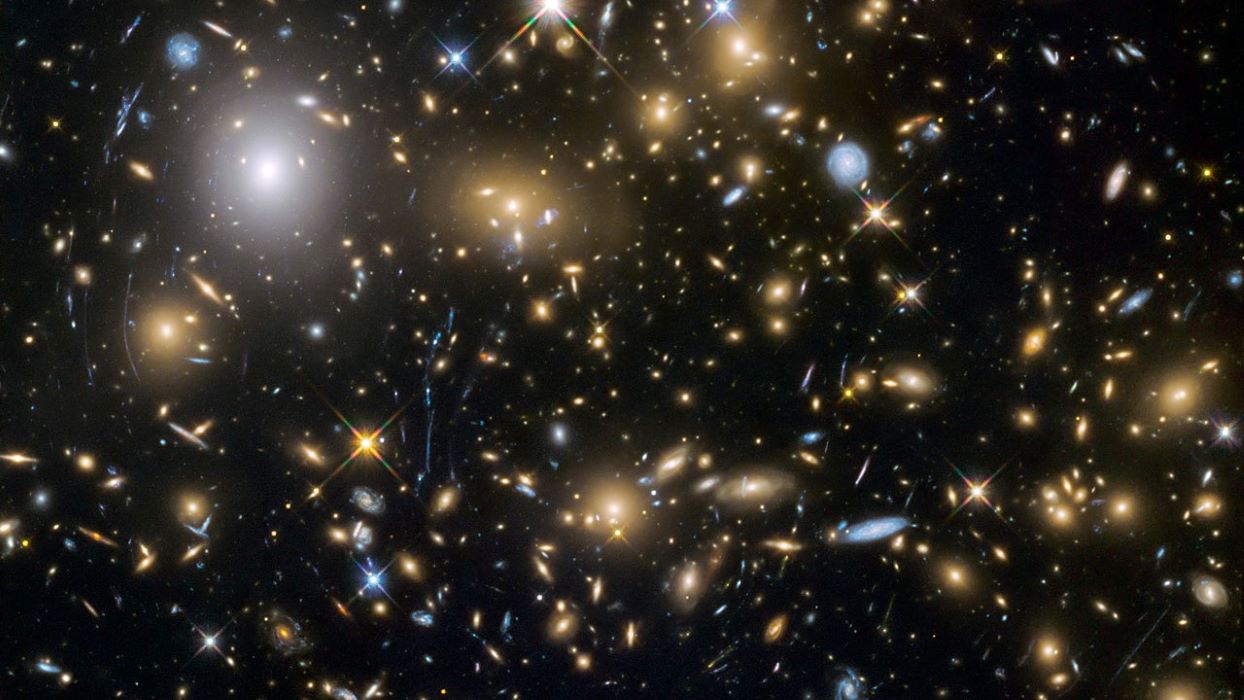The laws of physics used to be different, which may explain why you exist

The laws of physics were likely different in the deep past. (NASA)
The laws of physics must have been different at the start of the universe than they are now, according to a mind-bending study conducted by University of Florida astronomers, which provides clues to why stars, planets and life itself managed to form in the universe.
After analyzing the distribution of a whopping million, trillion groups of galaxies, the scientists discovered that physical laws once preferred one set of shapes over their mirror images. It’s as if the universe itself used to favor right-handed things instead of left-handed things, or vice versa.
The findings, made possible in part by UF’s supercomputer HiPerGator, chip away at explaining perhaps the biggest question in cosmology: Why does anything exist? That’s because some kind of handedness at the earliest moments of creation is necessary to explain why the universe is made of matter, the stuff that makes everything we see. The results also help confirm a central tenet of the Big Bang theory of the origin of the universe.
“I’ve always been interested in big questions about the universe. What is the beginning of the universe? What are the rules under which it evolves? Why is there something rather than nothing?” said Zachary Slepian, a UF astronomy professor who supervised the new study. “This work addresses those big questions.”
Slepian worked with UF postdoctoral researcher and the study’s first author, Jiamin Hou, and Lawrence Berkeley National Laboratory physicist Robert Cahn to conduct the analysis. The trio published their findings May 22 in the journal Monthly Notices of the Royal Astronomical Society.
Mirror image
Their study was designed to look for violation of a concept known as “parity symmetry” in physics, which refers to mirror-image reflections akin to left- or right-handedness. Many things in physics can be said to have a handedness, like the spin of an electron. The laws of physics today don’t usually care if this spin is left or right handed, though. That equal, or symmetric, application of the laws of physics regardless of handedness is referred to as parity symmetry.
The only problem is that parity symmetry must have been broken at some point. Some ancient parity violation – some kind of preference for right-handed or left-handed stuff in the distant past – is required to explain how the universe created more matter than antimatter. If parity symmetry held during the Big Bang, equal portions of matter and antimatter would have combined, annihilated one another, and left the universe completely empty.
So in a recent paper published in Physical Review Letters, Slepian, Hou and Cahn proposed an inventive way to search for evidence that parity was indeed violated during the Big Bang. Their idea was to imagine every possible combination of four galaxies in the night sky. Connect those four galaxies together by imaginary lines, and you have a lopsided pyramid, a tetrahedron. This is the simplest 3D shape possible –and thus the simplest shape that has a mirror image, the key test for parity symmetry.
Their method required analyzing a trillion possible tetrahedrons for each of a million galaxies, an incredible number of combinations. “Eventually we realized we needed new math,” Slepian said.
So Slepian’s team developed sophisticated mathematical formulas that allowed the immense calculations to be performed in a reasonable period. It still required a considerable amount of computational power. “UF’s unique technology we have here with the HiPerGator supercomputer and its advanced GPUs allowed us to run the analysis thousands of times with different settings to test our result,” he said.
Slepian’s group discovered that, indeed, the universe imprinted an early preference for left- or right-handed stuff onto the material that eventually became today’s galaxies. (The complex math makes it difficult to say whether that preference was for right-handedness or left-handedness, though.)
They established their finding with a degree of certainty known as seven sigma, a measure of how unlikely it is to achieve the result based on chance alone. In physics, a result with a significance of five sigma or higher is typically considered reliable because the odds of a chance result at this level are vanishingly small. A similar analysis, conducted by a former Slepian lab member using the method proposed by Slepian, Cahn, and Hou, identified the same universal handedness preference, albeit with slightly less statistical confidence due to differences in the study design.
It remains possible that uncertainty in the underlying measurements could explain the asymmetry. Thankfully, much larger samples of galaxies from next-generation telescopes could provide enough data to erase these uncertainties in just a few years. Slepian’s group at UF will perform their analysis on this new, more robust data as part of the Dark Energy Spectroscopic Instrument telescope team.
This is not the first time parity violation has been spotted, but it is the first evidence of parity violation that could affect the three-dimensional clustering of galaxies in of the universe. One of the fundamental forces, the weak force, also violates parity. But its reach is extremely limited, and it cannot influence the scale of galaxies nor explain the abundance of matter in the universe. That universal influence would require a parity violation to occur right at the moment of the Big Bang, a period known as inflation.
“Since parity violation can only be imprinted on the universe during inflation, if what we found is true, it provides smoking-gun evidence for inflation,” Slepian said.
The findings by Slepian’s lab can’t yet explain how the laws of physics changed, which will require new theories going beyond the Standard Model, a theory that explains our current universe. Now the race is on for scientists to produce this theory that can explain the universe’s ancient handedness and the abundance of matter we see today.
